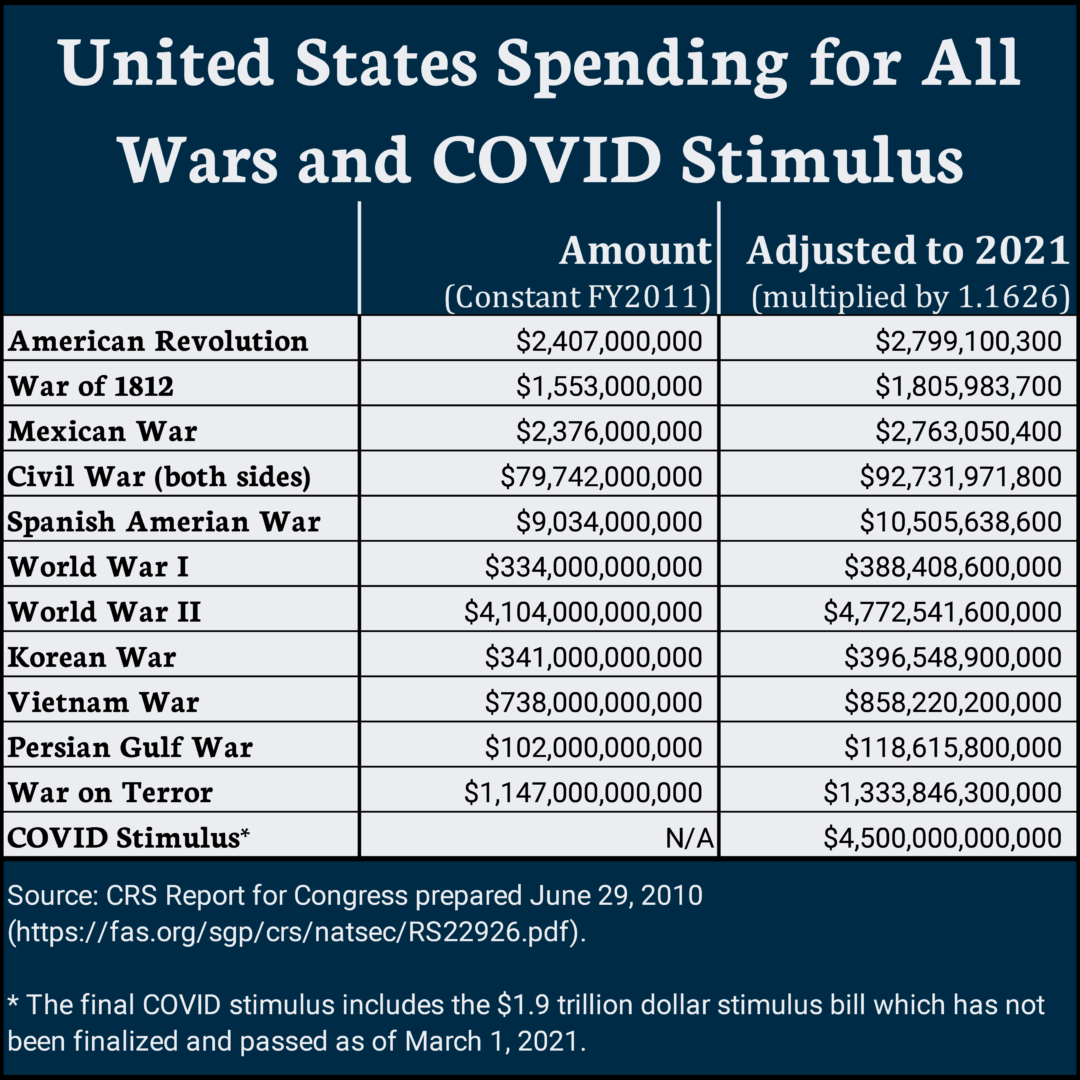Counting the Colossal Costs of COVID-19: March Newsletter Excerpt

In the context of horrific loss and suffering, we are getting a steady stream of wonderful news. By the end of May, there should be enough vaccine for all Americans. The benefits of herd immunity should start coming into effect in April and we are on a robust path to normalcy and economic recovery.
This has been an indelible experience for the human race. It will be talked about for centuries to come and a strong point of our global consciousness for the coming decades.
The War on COVID
It is easy for large numbers to feel like abstract statistics. Respectfully, we wish to put the human toll aside for a moment to try to get a relative sense of some of the financial toll from the pandemic.
As we send this out, the United States Congress is debating the new stimulus package. It is an eye popping $1.9 trillion dollars. Some form of this bill is expected to pass by March 14, 2021 when unemployment benefits run out. For our analysis, let’s assume the bill passes as is. This bill would bring the total COVID related stimulus spending up to $4.5 trillion.
To put this in perspective, let’s look at the cost of past American Wars adjusted to today’s dollars. The total cost of the American Revolutionary War was around $2.8 billion dollars in 2021 dollars. For comparison, two weeks ago the Perseverance rover landed on Mars. The lifetime cost of this mission is expected to be $2.7 billion dollars. Or, Allegiant Stadium, the new home of Las Vegas Raiders cost $1.9 billion. Again, this is all in today’s dollars – war was much more affordable in times past … or football as expensive as liberty.
If you added up the cost of all American Wars, excluding World War II, the total would be $3.2 trillion in today’s money. The total cost of World War II was $4.77 trillion. The total amount of COVID related stimulus fits somewhere between these two numbers. We can see this comparison visually below (the numbers are in millions, with six zeros removed):
Or here’s a table of these figures:

So yea, that’s a nutty amount of money being thrown at this. In the heat of war, nobody’s counting the cost of bullets. When peace comes, people will want to know why 100 bullets were used when 99 may have done the job. Was $4.5 trillion in federal spending necessary when $4.4 could have done the trick? Economists will be debating the appropriateness of the level of appropriations for ages. When the masks come off, we’ll certainly see some frowning faces.
We saw this same pattern with the government actions taken to fend off the 2008 Financial Crisis. While it was ultimately a success, it came with some misappropriation. It’s fair to say that public money shouldn’t be given to people and companies who didn’t ask for it, need it, let alone want it. It will be hard to justify to future generations why we created trillions of public debt when large portions went into savings or paid down mortgages. To be clear, much of it was essential to ease suffering and hold folks over as the crisis was managed, but certainly not all.
When the government hands out money, it may not seem fair to not receive some. However, the disbursement of public funds is not about equitability, but equality and stability. Unfortunately, the political climate is not warm to giving money exclusively to those who need it. Indeed, we have traded the frowns of today for tomorrow’s frowns.
The Greatest Possible Stimulus
Obviously, beyond the economics, we celebrate the lives saved through the COVID-19 vaccines, along with what may come from the new mRNA technology. In the long run, we may find that fast tracking this technology may be the basis for saving many lives against multiple diseases.
In addition to the human benefits, the vaccines are unlocking the massive global economic potential that has been partially dormant for 12 months. The effect of reopening is likely to be more impactful than the trillions that have been thrown at the economy.
We expect to see the economic improvement to track with vaccinations and reopening. President Franklin Roosevelt famously said that, “the only thing we have to fear is fear itself.” This is true especially with the economy and stock market which is closely tied to societal psychology. When people are justifiably scared, they freeze up and don’t spend money or take business risks. It can’t be overstated what a psychological boon it will be to see masks safely coming off faces, social distancing no longer needed, people laughing loudly at restaurants, browsing stores when they don’t actually need anything, kids going completely back to in-person learning, and people returning to their workplaces. Naturally you can add to this the joy of plummeting cases, declining hospitalizations, fewer lives lost, and the general lack of fear of catching a deadly virus. We expect people across the globe to do the things that typically create economic growth and prosperity, and for that we are thrilled.
It has been a long, sad, and destructive journey. We are not yet at a point where we can celebrate an official end, or accurately assess the efficacy of our response and the mistakes that we made. For now, we celebrate the light at the end of the tunnel that the vaccines give us. It is the kind of stimulus the world truly needs.
…
To subscribe to the monthly GreenStar Monthly Review Newsletter, please click here and scroll down

